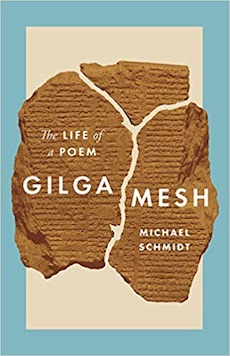By Louis J. Kern
Evoking the universal existential condition, Salman Rushdie wrote: “meaning being a thing human beings constructed out of familiarity, out of scraps they possessed of the known, like a jigsaw puzzle with many pieces missing meaning was the frame human beings placed around the chaos of being to give it shape” (Two Years, Eight Days and Twenty-Eights Nights, 2015). Metaphorically, this provides an apt description of the process of incremental discovery, tortuous translation, and reworking of the oldest and longest poem in world history—Gilgamesh.
Michael Schmidt reveals the complex ongoing history of the text, its various translations, its influence on and appropriation by modern poets, and its creation over a long Assyrian history from 2000 BCE to 700 BCE. Though he cites the “rediscovery” of the text in the British Museum and its translation by George Smith in 1872, he ignores the heroic archeological work of Austen Henry Layard and Hormuzd Rassam in 1847—the discovery of the ruins of Nineveh and the library of Ashurbanipal, revealing the first tabular fragments of Gilgamesh.
This series of unconnected poems composed and inscribed in cuneiform on clay tablets over widely separated periods lacks narrative subjectivity; it is a rootless, anonymous, multi-authored work that may have been originally oral and only later committed to clay. Its current form, in various poetic renderings, is a synthetic construction of pieced-together fragments; it will never have a definitive edition but will remain an open text, always seeking amendment and clarification as more shards of Akkadian tablets are discovered. For modern readers it presents unique challenges since it invites less interpretation than participatory reconstruction and constant attentiveness to its historical otherness; it is a treacherous and profoundly remote even alien text for modern sensibilities.
The most complete modern text, collected from fragments of the poem in Old Babylonian by the Mesopotamian hierophant and magus Sin-leqe-unninni, was compiled into an integrated text in Standard Babylonian between 1300 BCE and 1000 BCE. Schmidt resists the temptation to denominate it an epic, preferring to see it as a widely multi-genre work—historic chronicle, heroic myth, sacred text, proverbial guide, etc. It is clearly grounded in a real historical figure, a Sumerian king (originally Bilgames) during the Second Early Dynastic Period (ca. 2700-2500 BCE) who ruled the city of Uruk (today Al-Warka, Iraq) on the Euphrates with a population of 50-80,000, the largest city of its time.
Schmidt provides a synoptic view of Gilgamesh but is centrally concerned with translations and literary re-workings of the text by modern poets. He disapproves of its ahistorical readings, the fashionable criticism with its “determined single-mindedness” and “distorting filters.” His quest is to “work out the poem’s own terms and to read it in the ways . . . that it asks to be read.” Such reading for Schmidt ideally means direct contact with the cuneiform text; but since he cannot read the language he relies on an expert translation—the Oxford Assyriologist Andrew George’s 2003 text.
While acknowledging its broad modern appeal and its widespread use in college curricula—Jenny Lewis and Philip Terry’s Dictator (2018), a translation in Globish (a business language); Philip Roth’s The Great American Novel (1973) with pitcher Gil Gamesh; and Sadam Hussein’s anonymous Zabibah wal-Malik (Zabibah and the King, 2000)—Schmidt downplays the vast popular cultural presence of the saga. Though rightfully condemning its misunderstanding as a prolepsis for biblical accounts, he minimizes its universal appeal: the Everyman doppelgӓnger (Gilgamesh/Enkidu) triumphing over life’s challenges and coming to terms with his mortality, as proclaimed in its incipit: Sa naqba imuru or ša nagbu imuru—“he who looked into the depths; who saw the abyss.”
Louis J. Kern (ΦBK, Clark University) is professor emeritus of history at Hofstra University. Hofstra University is home to the Omega of New York chapter of Phi Beta Kappa.




